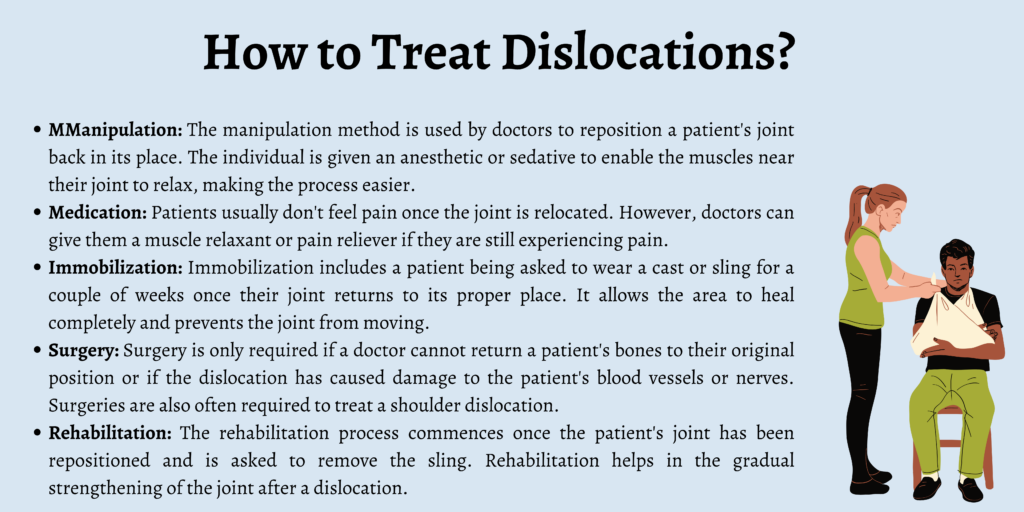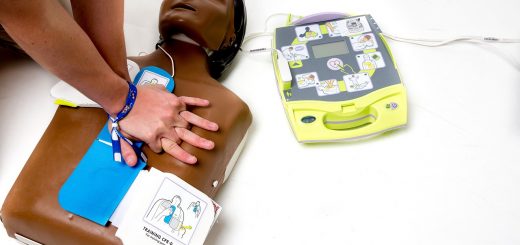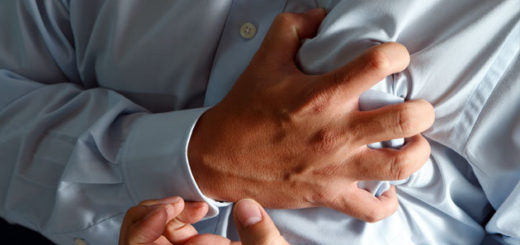First Aid For Dislocations
A dislocation occurs when the bones in a person’s joint get pushed or knocked out of their usual location. For instance, the top of a human being’s arm bone fits into a joint at the shoulder. If in case it pops or slips out of that very joint, it results in a dislocated shoulder.
Similarly, a person can dislocate joints such as their ankle, knee, shoulder, or hip. Joints are part of a human’s skeletal system, where two bones meet.
Dislocation can tear and strain the body tissues around one’s joints. They are not only painful, but they also make it tough for the affected joint to be used. It can
also cause a bone to move to a place where it doesn’t belong, giving rise to an urgent medical situation.
A dislocation can damage a person’s blood vessels, nerves, or ligaments if not treated immediately or properly.
Types of Dislocations
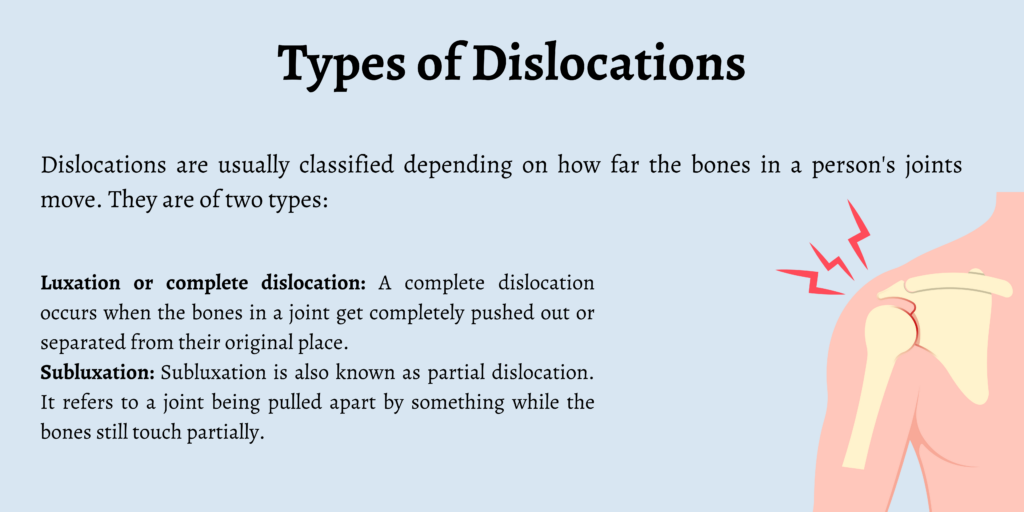
Dislocations are usually classified depending on how far the bones in a person’s joints move. They are of two types:
Luxation or complete dislocation: A complete dislocation occurs when the bones in a joint get completely pushed out or separated from their original place.
Subluxation: Subluxation is also known as partial dislocation. It refers to a joint being pulled apart by something while the bones still touch partially.
What Are The Signs And Symptoms of a Dislocation?
In addition to the physical signs and symptoms, the history will also suggest a dislocation, for example the patient experiencing a recent fall followed by a reduced range of movement in a particular joint. In the majority of cases, the affected joint will swell significantly and feel painful, especially if pressure is applied.
Some dislocations, especially those in patients who have experienced numerous recurrent dislocations at the same joint, may present with mild pain due to the laxness of the muscles and supporting tissues.
The chance of a patient dislocating their joint again is primarily related to their age, for example, young people (less than 20) have a very high rate of re-dislocating their shoulder – 90 per cent or higher. The older the patient gets, the less chance there is of re-dislocating.
Symptoms of dislocations and subluxations may include:
- pain in the injured area;
- swelling in the injured area;
- difficulty using or moving the injured area in a normal manner;
- deformity of the dislocated area; and
- warmth, bruising, or redness in the injured area.
In the majority of cases, swelling associated with dislocations are minimal due to the fact that joints have very limited blood supply. An exception to this is the patella (kneecap), where the close proximity of the popliteal artery and the strong attachments of this blood vessel to the femur and tibia make it vulnerable to damage.
Dislocation Risk Factors
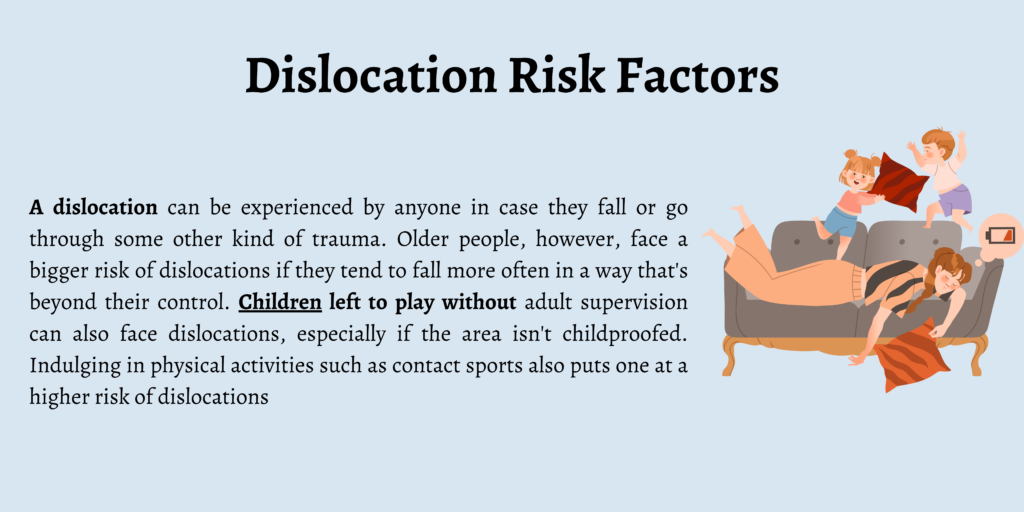
A dislocation can be experienced by anyone in case they fall or go through some other kind of trauma. Older people, however, face a bigger risk of dislocations if they tend to fall more often in a way that’s beyond their control. Children left to play without adult supervision can also face dislocations, especially if the area isn’t childproofed. Indulging in physical activities such as contact sports also puts one at a higher risk of dislocations.
What is The Recovery Time After a Dislocation?
The recovery period for every dislocation differs based on the dislocated joint and whether the victim went through any other injuries. Most individuals heal after a couple of weeks.
Certain joints, though, such as one’s hips, could take years to recover completely, accompanied by surgeries. On the other hand, a dislocated finger could heal in about three weeks. Always consult your doctor regarding the healing period of your dislocation.
Suppose a person returns to playing sports or doing heavy workouts while the joint hasn’t healed. In that case, it makes them susceptible to dislocating it again. Ask them how long they must wait after the incident to return to physical activity, such as exercise or sports.
How Can I Prevent a Dislocation?
Dislocations normally happen due to accidents that can’t be predicted. There are, however, a few things one can remember to stay as safe as possible while playing sports or engaging in other physical activities:
- Put on the right kind of protective gear
- Don’t continue playing or exercising if you have joint pain after or during the physical activity
- Always stretch well before playing or working out
- Allow your body to cool down after the activity and do your post-workout stretches
- Ensure your body receives enough time to recover and rest after a workout
Some general tips that can help in preventing dislocations are:
- Make use of handrails every time you go up and down the stairs
- Always keep a first aid kit within reach whenever possible
- Stay away from throw rugs
- See to it that your floor isn’t covered with electrical cords
- Don’t climb on tools such as tables or chairs to reach an area or get things off a shelf
Prevention techniques for kids include:
- Keep your home childproof and safe
- Make sure your staircases have gates
- Supervise your kids, especially during playtime
What Are The Common Complications of a Dislocation?
A dislocation can often lead to other complications as well. While some happen during the first couple of hours or days post the dislocation, others develop with time. The complications associated with dislocations are as follows:
Fractures
An injury that causes a dislocation can also cause fractures. In certain rare cases, fractures lead to swelling of the nearby muscles to the point where blood flow to the affected limb gets blocked or reduced.
In case the flow of blood isn’t restored on time, the limb can turn blue, causing the tissues in the limb to get damaged.
Nerve Damage
Dislocations can often cause a person’s nerves to get bruised or stretched. Nerves can also get crushed in such situations, causing more harm than bruised nerves. Certain rare cases also cause a patient’s nerves to tear, which do not heal on their own.
Surgeries are required to repair torn nerves; not every nerve injury heals completely.
Bleeding
If the dislocation is too traumatic or severe, it can lead to internal bleeding. A patient who has experienced a dislocation can also suffer from external bleeding if the dislocated bone affects their skin.
Infections
When a dislocated joint leads to tearing of the skin, it can cause wounds. The wounds could, in turn, get infected, spreading to the patient’s bone, leading to osteomyelitis, which is bone inflammation due to an infection.
How are Dislocations Diagnosed?
If someone feels they have suffered a dislocation, they must be taken to a hospital immediately. Once they reach the medical facility, they must undergo a physical examination to examine their joints and the surrounding areas.
The doctor will check if their skin and the circulation in the area have been affected. They could conduct the following tests on the victim:
- X-ray
- MRI
- CT scan
- Ultrasound
How to Treat Dislocations?
The treatment of a dislocation varies depending on the joint that has been dislocated and how severe the patient’s condition is. The RICE method is the initial form of treatment for dislocation, which entails rest, ice, compression, and elevation.
If the joint doesn’t return to its normal position naturally, the following modes of treatment can be used:
- Manipulation: The manipulation method is used by doctors to reposition a patient’s joint back in its place. The individual is given an anesthetic or sedative to enable the muscles near their joint to relax, making the process easier.
- Medication: Patients usually don’t feel pain once the joint is relocated. However, doctors can give them a muscle relaxant or pain reliever if they are still experiencing pain.
- Immobilization: Immobilization includes a patient being asked to wear a cast or sling for a couple of weeks once their joint returns to its proper place. It allows the area to heal completely and prevents the joint from moving.
- Surgery: Surgery is only required if a doctor cannot return a patient’s bones to their original position or if the dislocation has caused damage to the patient’s blood vessels or nerves. Surgeries are also often required to treat a shoulder dislocation.
- Rehabilitation: The rehabilitation process commences once the patient’s joint has been repositioned and is asked to remove the sling. Rehabilitation helps in the gradual strengthening of the joint after a dislocation.
Conclusion
Although every dislocation heals in its own time, most heal completely. When treated properly and on time, it reduces the chances of the patient suffering from any further injury.
However, victims should remember that dislocating a joint increase the possibility of them dislocating it again. Therefore, precautions should be taken, and people should wear protective gear to shield themselves from future dislocations.
FAQs
1. How many types of dislocations are there?
There are two types of dislocations, namely complete and partial dislocations.
2. What are the joints that can get dislocated?
The joints that can get dislocated include shoulders, fingers, knees, hips, elbows, and ankles.
3. What is the healing time for a dislocation?
The healing time for a dislocation depends on the joint that has been dislocated and the presence of other accompanying injuries.
4. How can dislocations be treated?
Treating a dislocation could involve medication, repositioning or manipulation, rehabilitation, surgery, and immobilization.
5. How can a dislocation be diagnosed?
After a physical examination, a doctor could ask the patient to get an X-ray, MRI, CT scan, or ultrasound done to diagnose a dislocation.
6. How can I prevent dislocations?
Dislocations can be prevented by keeping one’s home environment safe, wearing the right gear while exercising and playing sports, and supervising kids during playtime.

